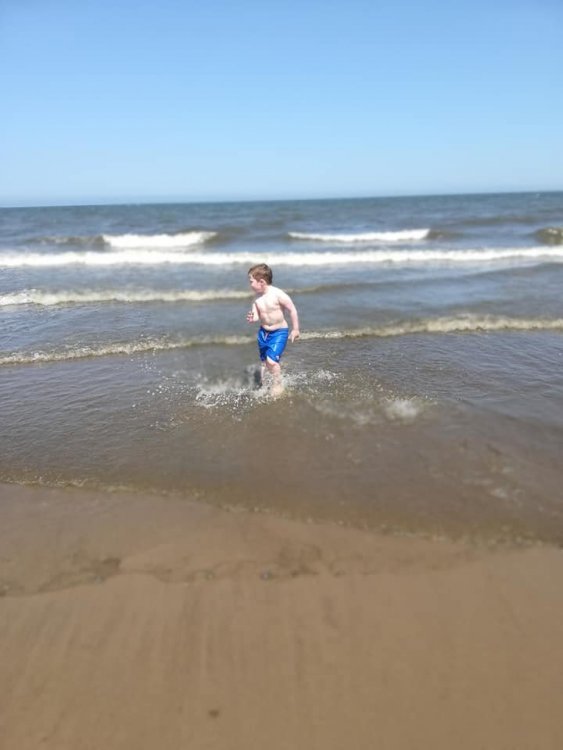-
Posts
20,847 -
Joined
-
Last visited
-
Days Won
49
Everything posted by CaaC (John)
-
You just have to keep your chin up buddy and plod along, Me and the wife have been all through that over the years and we are now both 70 odd so we consider we have had a good life up to know and are still in the land of the living.
-
We have the heat and now we have the storms following, plenty of thunder and lightning around. Homes powerless in Aberdeen after lightning storms hit Scotland BBC Weather - Scotland Lightning in Shandon, Argyll and Bute, Saturday Udny Aberdeenshire, Saturday.
-
They are off to a flyer.......so far, 84-0-36.0, but they have a habit of...
-
Hubble Catches a Bounty of Stars and Cosmic Dust This Hubble Space Telescope image shows the spiral galaxy Messier 98, which is located about 45 million light-years away in the constellation of Coma Berenices (Berenice's Hair). The galaxy was discovered in 1781 by the French astronomer Pierre Méchain, a colleague of Charles Messier, and is one of the faintest objects in Messier’s astronomical catalog. Messier 98 is estimated to contain about a trillion stars, and is full of cosmic dust — visible here as a web of red-brown stretching across the frame — and hydrogen gas. This abundance of star-forming material means that Messier 98 is producing stellar newborns at a high rate; the galaxy shows the characteristic signs of stars springing to life throughout its bright center and whirling arms. This image of Messier 98 was taken in 1995 with the Wide Field and Planetary Camera 2, an instrument that was installed on Hubble from 1993 until 2009. These observations were taken in infrared and visible light as part of a study of galaxy cores within the Virgo Cluster, and feature a portion of the galaxy near the center. Text credit: ESA (European Space Agency) Image credit: ESA/Hubble & NASA, V. Rubin et al.
- 1,657 replies
-
- space exploration
- astronomy
-
(and 1 more)
Tagged with:
-
Desert-dwelling carnivorous dinosaur found in Brazil afp.com © Heitor MARCON State University of Maringa paleontologists work at the site where fossilised bones of a dinosaur were found in Maringa, Parana state, Brazil A desert-based carnivorous dinosaur that used claws to capture small prey 90 million years ago has been unearthed in southern Brazil, scientists said Wednesday. Just over a meter and a half in length (five feet), the fossil remains of the Vespersaurus paranaensis were found in Cruzeiro do Oeste municipality of Parana state, a team of paleontologists from Brazil and Argentina said in a statement. © Heitor MARCON A hitherto unknown type of carnivorous dinosaur measuring just over a meter and a half long that lived 90 million years ago has been identified in the Cruzeiro do Oeste municipality of southern Brazil The Vespersaurus was a theropod, a group of two-footed, meat-eating dinosaurs that included the better-known tyrannosaurus and velociraptor. Footprints now believed to belong to this new species of dinosaur were discovered in Cruzeiro do Oeste in the 1970s. "It's incredible that, nearly 50 years later, it seems that we have discovered what type of dinosaur would have produced those enigmatic footprints," said Paulo Manzig of the Paleontology Museum of Cruzeiro do Oeste. The northeastern region of Parana was once a desert and the dinosaur's remains suggest that the Vespersaurus was well adapted to that type of climate. Other dinosaur species have been found there and, according to the scientists, the latest discovery must "catapult" paleontological investigations in the region. "It is a rich but little explored area that would surely bring great news to the world of paleontology," said Neurides Martins of the Paleontology Museum of Cruzeiro do Oeste. https://www.msn.com/en-gb/news/offbeat/desert-dwelling-carnivorous-dinosaur-found-in-brazil/ar-AADuf7L
-
Beautiful sunny and warm day yesterday so the Daughter took wee Kaiden and friends to Portobello beach here in Leith (Edinburgh) for a swim and play in the sand, Bonny Scotland does have some good beaches as this is one of them.
-
Cricket World Cup: Fan trouble at Pakistan v Afghanistan at Headingley Action will be taken to punish fans involved in "scuffles" at the World Cup match between Pakistan and Afghanistan at Headingley, says the International Cricket Council. Videos on social media showed fans clashing outside the ground and a group trying to break through the gates between the main road and the ground in Leeds. Fans were also seen jumping over the fence that surrounds the ground and gaining access to the concourse behind the Western Terrace. An ICC spokesperson said they were aware of "some scuffles among a minority of fans". It was also reported that there were "physical clashes" in the stands, which led to some being evicted from the stadium. "We are currently working with the venue security team and local police force to ensure there are no further incidents," the spokesperson added. "We do not condone this type of behaviour, and will take appropriate action against any anti-social behaviour that spoils the enjoyment for the majority of fans." West Yorkshire Police police said they were called to "reports of some trouble outside the ground linked to people trying to get in". "Officers attended to disperse the group without any issues and remained on patrol in the area," a statement added. https://www.bbc.co.uk/sport/cricket/48812583
-
Big birds: Giant, 1,000-pound birds once roamed around Europe Doyle Rice Talk about your big bird. At 1,000 pounds and over 10 feet tall, it was one of the largest birds that ever lived in Earth's history. And almost 2 million years ago, early Europeans lived alongside some of these huge birds, according to new research published Wednesday. Bones of the huge, long-extinct bird were recently discovered in a cave in Crimea. "We estimate it weighed about 1,000 pounds," said study lead author Nikita Zelenkovof the Russian Academy of Sciences. "This formidable weight is nearly three times the largest living bird, the common ostrich, and nearly as much as an adult polar bear." The bird would have towered above early humans. Scientists speculate that it was likely flightless but was probably able to run quite fast. Speed may have been key to the bird's survival, the study said. Alongside its bones, scientists also found fossils of huge carnivores such as giant cheetah, giant hyenas and sabre-toothed cats. According to the study, the bird may have also been a source of meat, bones, feathers and eggshells for early humans. It was previously thought that such giant birds only lived on the islands of Madagascar and New Zealand as well as Australia. This is the first giant bird ever discovered in the Northern Hemisphere. What current bird might it most resemble? "We don't have enough data yet to say whether it was most closely related to ostriches or to other birds," Zelenkov said. The bones were discovered during the construction of a new highway in Crimea. "Last year, mammoth remains were unearthed (there) and there may be much more the site will teach us about Europe's distant past," he said. The study was published in the peer-reviewed Journal of Vertebrate Paleontology. https://www.msn.com/en-gb/news/offbeat/big-birds-giant-1000-pound-birds-once-roamed-around-europe/ar-AADu1QJ
-
Dragonfly: Drone helicopter to fly on Saturn's moon, Titan Nasa will fly a drone helicopter mission to cost $1bn (£800m) on Saturn's moon, Titan, in the 2030s. The rotorcraft will visit dozens of promising locations on Titan to investigate the chemistry that could lead to life. Titan plays host to many of the chemical processes that could have sparked biology on the early Earth. The eight-rotor drone will be launched to the Saturnian moon in 2026 and arrive in 2034. It will take advantage of Titan's thick atmosphere to fly to different sites of interest. Video Dragonfly was selected as the next mission in Nasa's New Frontiers programme of medium-class planetary science missions. It was in competition with the Comet Astrobiology Exploration Sample Return (CAESAR) mission, which would have delivered a sample from a comet to Earth. Titan has wind, rivers, seas and lakes, just like Earth - but with an exotic twist. The huge moon (it is second only in size to Jupiter's moon, Ganymede) has its own seasonal cycle, where wind and rain have shaped the surface to form river channels, seas, dunes and shorelines. The average temperature of -179C (-290F) means that mountains are made of ice, and liquid methane assumes many of the roles played by water on Earth. Dragonfly will first land at the "Shangri-La" dune fields, which are similar to the linear dunes found in Namibia in southern Africa. The drone will explore this region in short flights, building up to a series of longer "leapfrog" flights of up to 8km (5 miles), stopping along the way to take samples. "Flying on Titan is actually easier than flying on Earth," said the mission's principal investigator Elizabeth "Zibi" Turtle, from Johns Hopkins University Applied Physics Laboratory in Maryland. "The atmosphere is four times denser at the surface than the atmosphere at the surface of Earth and the gravity is about one-seventh of the gravity here on Earth." She added: "Its the best way to travel and the best way to go long distances so that we can make measurements in a variety of different geologic environments." It will finally reach the Selk impact crater, where there is evidence of past liquid water and organics - the complex carbon-based molecules that are vital for life. These may have existed together for tens of thousands of years. "What really excites me about this mission is that Titan has all of the key ingredients needed for life," said Dr Lori Glaze, the director of planetary science at Nasa. "Liquid water and liquid methane. We have the complex organic carbon-based molecules. And we have the energy that we know is required for life. "So we have on Titan opportunity to observe the processes that were present on early Earth when life began to form and possibly even conditions that may be able to harbour life today." In addition to studying this "pre-biotic chemistry", Dragonfly carries instruments that can investigate the moon's atmosphere and the water-ammonia ocean thought to lie beneath its surface. It will also search for chemical evidence of past or present life. "With the Dragonfly mission, Nasa will once again do what no-one else can do," said the US space agency's administrator, Jim Bridenstine. "Visiting this mysterious ocean world could revolutionise what we know about life in the Universe. This cutting-edge mission would have been unthinkable even just a few years ago, but we're now ready for Dragonfly's amazing flight." The lander could eventually fly more than 175km (108 miles) - nearly double the distance travelled to date by all Mars rovers combined. Dragonfly will be powered by a Multi-Mission Radioisotope Thermoelectric Generator (MMRTG), which converts the heat released by the decay of a radioactive material into electricity. While there is enough sunlight at Titan's surface to see, there is not enough to use solar power efficiently. https://www.bbc.co.uk/news/science-environment-48799315
- 1,657 replies
-
- 1
-

-
- space exploration
- astronomy
-
(and 1 more)
Tagged with:
-

Manchester City Discussion
CaaC (John) replied to a topic in Premier League - English Football Forum
-
Plant-eating crocodiles thrived in dinosaur times Tim Vernimmen In children’s books and cartoons, crocodiles and their kin tend to have an impressive array of identical teeth, each shaped like a sharp, pointed weapon primed for tearing through flesh. In reality, there is often a bit more variation, says palaeontologist Keegan Melstrom of the University of Utah. “But that is nothing compared to the staggering diversity in the teeth of extinct crocodile-like reptiles, or Crocodyliformes,” he says. “Some of those extinct crocs had really weird teeth.” Now, an analysis of 146 fossilized teeth belonging to 16 extinct crocodile relatives has revealed something surprising: At least three times in their history, ancient croc cousins became vegetarians. “This shows that this was a successful dietary strategy,” says Melstrom, whose team presents the results today in the journal Current Biology. “And I think that as we find more teeth in the future, we are likely to find even more groups that independently became herbivores.” Dedicated chomping For their analysis, Melstrom and coauthor Randall Irmis, also of the University of Utah, adopted a method that was especially developed to compare dissimilar teeth, borrowed from earlier work by palaeontologists studying ancient mammals. “What it comes down to is that we count how many separate surface areas there are on every tooth,” Melstrom says. “We consider them to be separate if they are tilted in a different direction.” Based on research in mammals as well as reptiles alive today, scientists know that carnivores tend to have simple teeth with very few separate surfaces. The Komodo dragon, for instance, is a predator with teeth that look like steak knives—thin and sharp, straight and simple, with no frills. These teeth are great for catching prey and slicing it into chunks that the lizard can then swallow without chewing. At the other extreme are animals with teeth full of nooks and crannies that increase their surface area, creating more space and different tools to grind away at various hardy plant parts. “These teeth almost invariably belong to animals that feed on plants, the leafs, branches, and stems of which often require a lot of chewing before they can be digested,” Melstrom says. Related Slideshow: Real-life dragons- Pets that look like mythical creatures (provided by StarsInsider) SLIDES As such, the teeth of the almost entirely carnivorous crocodilians alive today are usually rather simple, Melstrom explains, but some of the extinct species had teeth with up to 20 separate surfaces. This suggests that they probably engaged in some very dedicated chomping or possibly other behaviours that allowed them to nibble away on nutritious plants that were difficult to access. “One of the most complex teeth in the set we’ve studied are those of Simosuchus, a small crocodyliform with an almost rectangular snout, as if someone hit a crocodile in the head with a shovel,” Melstrom says. These teeth look remarkably like those of the marine iguana from the Galápagos, which grazes algae from the rocks. “Simosuchus wasn’t aquatic but probably did live near the water, so one might imagine it did something similar,” Melstrom says. Surprisingly, Melstrom’s study has now firmly established it was not just one wayward group that went vegetarian. It turns out there were at least three independent groups sporting a variety of more complex chompers, suggesting that a move to plant-based diets happened multiple times throughout evolution. Patrick O’Connor, a palaeontologist at Ohio University who was not involved in the study, is enthusiastic about the team’s approach. “This method can be replicated and expanded with the discovery of new fossils, which should allow us to test different ideas for why herbivory repeatedly evolved in crocs,” he says. His colleague Diego Pol, currently at the Museo Paleontológico Egidio Feruglio in Argentina, agrees, but he also warns that scientists shouldn’t take the diets suggested by tooth complexity for granted and should look for other lines of evidence to back up their conclusions. Select survivors Successful as they may once have been, herbivorous crocodyliforms didn’t make it past the mass extinction event that eliminated roughly three-quarters of all species on Earth about 66 million years ago—despite the fact that the crocodilians alive today were among the very few large four-limbed animals that did survive. And no herbivorous crocs have evolved since, maybe because mammals took their place in that ecological niche. “Becoming a herbivore always involves some kind of specialization,” says Attila Ősi, a Hungarian palaeontologist who discovered a fair number of the teeth used in the study, but who was not involved in the work. That might be a disadvantage when the plants you like disappear. Another clue may lie in the fact that not just the herbivores, but all fully terrestrial crocs have gone extinct. The two dozen species alive today inhabit lakes, rivers, and occasionally seashores, where they mostly feed on meat and fish. Still, even modern crocs are not strict carnivores. Many species have been found to occasionally eat fruit, sometimes straight from the tree. And American alligators fed largely plant-based diets for a few months did not appear to suffer any negative health consequences. Clearly, crocodilians are more flexible than they are usually given credit for, and today’s crocs are far better adapted than the common misnomer “living fossil” might imply. Mikael Fortelius of the University of Helsinki, Finland, did not work on this study but has used the method in mammals, and he agrees the label is often unhelpful. “Just like many extinct crocodyliforms were not carnivores, most ancient hyaenas weren't bone crushers and most rhinos didn't have horns,” he says. “Many animals alive today may not be typical of the groups they originate from.” https://www.msn.com/en-gb/news/offbeat/plant-eating-crocodiles-thrived-in-dinosaur-times/ar-AADxJme
-
-
Keep your chin up buddy, being made the member of the month means that people in here have not rejected you, me at my age have felt like that [There just seems to be always someone better] in my life but I just plodded along and things got better.
-
What a cracker of a yorker by Malinga taking out De Kock's leg stump, phew.
-
-
At least your beard is black, mine is bloody grey nowadays.
-
A huge burst of mysterious cosmic radio waves traced back to the exact location in a galaxy billions of light years away Phoebe Weston A huge one-off burst of mysterious cosmic radio waves has been precisely located to a galaxy 3.6 billion light-years away. The powerful shiver of waves came from a Milky Way-sized galaxy that scientists were able to pinpoint for the first time using three of the world’s largest optical telescopes. “This is the big breakthrough that the field has been waiting for since astronomers discovered fast radio bursts in 2007,” said lead author Keith Bannister, from Australia’s national science agency. © Thomson Reuters A Hubble Space Telescope image shows bright blue gas threading through the galaxy IC 4870 that shines because it emits radio wave and gamma-ray radiation, in this image obtained September 26, 2018. NASA/ESA/Hubble Space Telescope/Handout via REUTERS THIS IMAGE HAS BEEN SUPPLIED BY A THIRD PARTY. IT IS DISTRIBUTED, EXACTLY AS RECEIVED BY REUTERS, AS A SERVICE TO CLIENTS “If we were to stand on the Moon and look down at the Earth with this precision, we would be able to tell not only which city the burst came from, but which postcode and even which city block,” he said. The discovery was made by an Australian-led international team using a new radio telescope belonging to the Commonwealth Scientific and Industrial Research Organisation (CSIRO), the Australian science agency. Astronomers hope the breakthrough will move them closer to discovering the causes of fast radio bursts, which remain unknown, according to the study published in the journal Science. Since 2007, just 85 cosmic radio wave bursts have been detected. Most are “one-offs” but a small amount are “repeaters” which recur in the same place. Two years ago, astronomers found a “repeater” home galaxy but this is the first time they have exactly located a “one-off” ripple. Fast radio bursts last less than a millisecond which makes it incredibly hard to pinpoint their origin. The technology used in the discovery was the Australian Square Kilometre Array Pathfinder (ASKAP) radio telescope. Team member Dr Adam Deller from the Swinburne University of Technology, Melbourne said: “The burst we localised and its host galaxy look nothing like the ‘repeater’ and its host. It comes from a massive galaxy that is forming relatively few stars. © Heritage Space Spiral galaxy in Triangulum constellation. Artist NASA. (Photo by Heritage Space/Heritage-Images/Getty Images) “This suggests that fast radio bursts can be produced in a variety of environments, or that the seemingly one-off bursts detected so far by ASKAP are generated by a different mechanism to the repeater.” ASKAP is an array of multiple dish antennas and the burst had to travel a different distance to reach each antenna which means it arrived at slightly different times. ASKAP was able to freeze and save the data less than a second after the burst (FRB 180924) arrived at the telescope from its home galaxy (DES J214425.25?405400.81). “From these tiny time differences – just a fraction of a billionth of a second – we identified the burst’s home galaxy and even its exact starting point, 13,000 light-years out from the galaxy’s centre in the galactic suburbs,” said Dr Deller. To find out more about the home galaxy, the team imaged it with the European Southern Observatory’s Very Large Telescope in Chile and measured its distance with the Keck telescope in Hawaii and the Gemini South telescope in Chile. https://www.msn.com/en-gb/news/techandscience/huge-burst-of-mysterious-cosmic-radio-waves-traced-back-to-exact-location-in-galaxy-billions-of-light-years-away/ar-AADw5n5?MSCC=1561712335&ocid=chromentp
- 1,657 replies
-
- 1
-

-
- space exploration
- astronomy
-
(and 1 more)
Tagged with:
-
Can you spot the camouflaged animals in these photos? SLIDES 1/31
-
Ancient Roman shipwreck discovered undisturbed in the Mediterranean Samuel Osborne An ancient Roman-era shipwreck has been discovered at the bottom of the Mediterranean Sea off the eastern coast of Cyprus. Divers found it was still loaded with transport amphorae – large clay jars typically used for holding wine and other liquids. It is thought to be the first well-preserved discovery of its kind in the island nation’s history. File video: Deadly 102-year-old shipwreck discovered (Fox News) Cyprus’ Antiquities Department said the ship was most probably from Syria and ancient Cilicia on modern-day Turkey‘s southern coast. Underwater archaeologists were working to examine the ship, the department added. The wreck was found by a pair of volunteer divers with the University of Cyprus’ archaeological research unit. 20 haunting shipwrecks around the world The Antiquities Department said a study of the vessel was "expected to shed new light on the breadth and the scale of seaborne trade between Cyprus and the rest of the Roman provinces of the eastern Mediterranean". A number of ancient vessels have been found off the island's coast including one dating back the Greek era in the middle of the 4th century BC which is thought to be one of the region's best preserved/ Archaeologists working on that wreck said they had gained insights into the evolution of ancient boat-building in the region. https://www.msn.com/en-gb/news/world/ancient-roman-shipwreck-discovered-undisturbed-in-mediterranean/ar-AADwBuk?li=AAnZ9Ug
-
https://www.google.com/search?q=Recommended+Cricket+Equipment+-+Top+10&rlz=1C1CHBF_en-GBGB790GB790&oq=Recommended+Cricket+Equipment+-+Top+10&aqs=chrome..69i57j0.23239j0j1&sourceid=chrome&ie=UTF-8
-
David Turnbull: Motherwell midfielder's Celtic move collapses David Turnbull's £3.25m move to Celtic from Motherwell has collapsed after it emerged that the midfielder needs "immediate preventative" knee surgery. The clubs had been in talks after the deal was delayed following a medical and after a four-year deal was agreed. Motherwell says Celtic were still keen to sign Turnbull, 19, but that terms could not be struck after the Scottish champions submitted a revised offer. Turnbull will now have an operation and will be out for "an extended period". "We will give David all the support he needs during this process," read a statement from the Fir Park club. "We wish him the best with his procedure and rehabilitation, and look forward to watching him play in claret and amber again in the near future." More
-
This volcano just erupted after nearly a century of silence. Astronauts captured the breathtaking scene from 254 miles above. Matthew Cappucci Watching a volcano erupt would be cool. But having a front-row seat 254 miles above the volcano? That would be a view. Astronauts aboard the International Space Station captured the breathtaking scene Saturday showing the vigorous eruption of the Raikoke volcano. Raikoke is an uninhabited island along the Kuril chain, a necklace of narrow strip islands draped 500 miles from northern Japan to northeast Russia. Formerly owned by Japan, the volcanic island — which occupies an area less than two square miles — is under the control of Russia, and has been since World War II. The aerial view offers a perspective seldom seen during major eruptions. Like a thunderstorm, a mushroom cloud blossoms over the volcano, where ash is catapulted into the sky with explosive force. The updraft is so strong in the middle that it “outruns” the plume’s periphery, making the edges curl down before becoming entrained in the rising cloud again. During Saturday’s eruption, the plume may have rocketed up more than 50,000 feet (10 miles) It’s easy to guess which way the winds were blowing by looking at the photograph. A more diffuse, expansive sheet of ash clouds lingers downwind, transported by strong upper-level winds over the Sea of Okhotsk. Volcanic ash is heavy in silicates, which have a melting temperature close to 2,000 degrees. Many commercial aircraft engines operate at temperatures well over 2,500 degrees — meaning the dustlike particles would melt and stick to vital mechanics in the plane. That can cause them to “choke” an engine, making volcanic ash clouds dangerous for aviation. Volcanic ash can’t be seen on traditional radar or the forward-looking radar in the nose of most jets. That makes forecasting it vitally important. Visibly, ash clouds are easy to spot from far away, so they’re simple to avoid during the daytime. But if a plane was to enter an ash cloud at night, it would have one telltale sign: electricity arcing across the windshield. Volcanic ash clouds are highly electrified. If a plane flew into one, so much charge would build up that discharges of St. Elmo’s Fire would leap across the windshield like small lightning bolts. Raikoke’s ash cloud was no exception, with hundreds of lightning bolts leaping from the supercharged ash above. Atmospheric scientists refer to this lightning barrage as a “dirty thunderstorm.” The intensity and frequency of volcanic lightning discharges can offer insight about how robust the eruption was. Lightning activity peaked during four main periods, suggesting Raikoke’s eruption was several individual bursts. That’s also evident in the shape of the clouds: notice the downwind anvil is already there while a new plume immediately goes over the volcano. Near the base of the plume, a collar of white, puffy clouds can be seen. That’s water vapour — not ash. The enormous amount of gas and other materials released by the volcano probably contained water vapour, with the temperature contrast between the fiery plume and the air around it causing condensation. What would it be like under this cloud? First, you’d see the amber, sand-coloured anvil approaching. There might be an ominous display of mammatus clouds, the iconic pouch-like bags that hang beneath foreboding storms that usually are a sign of turbulence in the atmosphere. The sun would appear a creepy orange colour until it disappeared. Lightning would crackle, crawling along the anvil; the gases in the atmosphere would make it a neon-purple colour. Bolts would hit the ground as far as 60 miles away. Closer to the plume, you might get a spattering of small pebbles raining down, possibly with a thin glaze of ice around them, like rocky hailstones. Depending on the temperature of the atmosphere, deadly gas and ash might make it down toward the surface. A number of whirlwinds and waterspouts would likely also be dancing. Saturday’s eruption marks Raikoke’s first since 1924. Before that, a “catastrophic” eruption occurred in 1778. In the meantime, there’s no telling what Raikoke’s next move will be. https://www.msn.com/en-gb/news/world/this-volcano-just-erupted-after-nearly-a-century-of-silence-astronauts-captured-the-breathtaking-scene-from-254-miles-above/ar-AADuBrp?ocid=chromentp










.thumb.png.30cf5443d5593a7aa4e15f41a277741c.png)
.thumb.png.cf45e0b7048370eb3f087f680b7a17ba.png)






